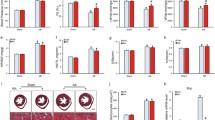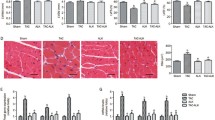Abstract
AdipoRon, a small-molecule adiponectin receptor (AdipoR) agonist, has been reported to be implicated in cardiovascular diseases. However, its role in pressure-overload-induced cardiac remodeling is still elusive. To elucidate the role of AdipoRon in the pathogenesis of cardiac remodeling in vivo and vitro, in the left ventricle of human end-stage heart failure, the expression of AdipoR2 is upregulated. Meanwhile, increased expression of AdipoR2 was also observed in mice failing hearts. Oral administration of AdipoRon alleviated cardiac hypertrophy and fibrosis induced by pressure overload, as evidenced by the beneficial change of cross-sectional area of cardiomyocytes, heart weight-to-body weight ratio, gene expression of hypertrophic markers, ventricle collagen ratio, and cardiac function. The AMPKα activation mediated by AdipoRon significantly inhibited AngII-induced TGF-β1 expression and cardiac fibroblast differentiation, and these inhibitory effects were abrogated by treatment with the AMPK inhibitor Compound C. Consistent with the above results, AdipoRon abolished the ability to retard AngII-induced TGF-β1 expression in AMPKα2−/− cardiac fibroblasts. In AMPKα2−/− mice subjected to aortic banding, AdipoRon abolished the protective effect, as indicated by increased cross-sectional area, cardiac collagen ratio, and cardiac dysfunction. Our results demonstrated that AdipoR2 expression was markedly increased in the failing hearts. AdipoRon inhibited TGF-β1 expression and myofibroblast differentiation in AMPKα-dependent manner in vitro. In line with the vitro results, AMPKα2−/− mice markedly abrogated the inhibitory effects of AdipoRon in cardiac remodeling. These results indicated AdipoRon may hold promise of an effective therapy against pressure-overload-induced cardiac remodeling.
Key messages
• The increased expression of AdipoR2 is observed in human and mice failing hearts, the changeable expression of AdipoR suggests the possible role of AdipoR in cardiac remodeling.
• Oral administration of AdipoRon alleviates cardiac hypertrophy and fibrosis induced by pressure overload, and AMPKα activation mediated by AdipoRon significantly inhibited AngII-induced TGF-β1 expression and cardiac fibroblast differentiation.
• These findings provide new mechanistic insight and open new therapeutic pathways for heart failure.







Similar content being viewed by others
References
Heineke J, Molkentin JD (2006) Regulation of cardiac hypertrophy by intracellular signalling pathways. Nat Rev Mol Cell Biol 7(8):589–600
Hill JA, Olson EN (2008) Cardiac plasticity. N Engl J Med 358(13):1370–1380
Xie M, Burchfield JS, Hill JA (2013) Pathological ventricular remodeling: therapies: part 2 of 2. Circulation 128(9):1021–1030
Berg AH, Combs TP, Scherer PE (2002) ACRP30/adiponectin: an adipokine regulating glucose and lipid metabolism. Trends Endocrinol Metab 13(2):84–89
Phillips SA, Kung JT (2010) Mechanisms of adiponectin regulation and use as a pharmacological target. Curr Opin Pharmacol 10(6):676–683
Gurbulak S, Akin F, Yerlikaya E, Yaylali GF, Topsakal S, Tanriverdi H, Akdag B, Kaptanoglu B (2016) Adiponectin and cardiac hypertrophy in acromegaly. Adv Clin Exp Med 25(3):449–455
Shibata R, Ouchi N, Ito M, Kihara S, Shiojima I, Pimentel DR, Kumada M, Sato K, Schiekofer S, Ohashi K, Funahashi T, Colucci WS, Walsh K (2004) Adiponectin-mediated modulation of hypertrophic signals in the heart. Nat Med 10(12):1384–1389
Hong SJ, Park CG, Seo HS, Oh DJ, Ro YM (2004) Associations among plasma adiponectin, hypertension, left ventricular diastolic function and left ventricular mass index. Blood Press 13(4):236–242
Holland WL, Scherer PE (2013) Cell biology. Ronning after the adiponectin receptors. Science (New York, NY) 342(6165):1460–1461
Okada-Iwabu M, Yamauchi T, Iwabu M, Honma T, Hamagami K, Matsuda K, Yamaguchi M, Tanabe H, Kimura-Someya T, Shirouzu M, Ogata H, Tokuyama K, Ueki K, Nagano T, Tanaka A, Yokoyama S, Kadowaki T (2013) A small-molecule AdipoR agonist for type 2 diabetes and short life in obesity. Nature 503(7477):493–499
Zhang Y, Zhao J, Li R, Lau WB, Yuan YX, Liang B, Li R, Gao EH, Koch WJ, Ma XL, Wang YJ (2015) AdipoRon, the first orally active adiponectin receptor activator, attenuates postischemic myocardial apoptosis through both AMPK-mediated and AMPK-independent signalings. Am J Phys Endocrinol Metab 309(3):E275–E282
Deng W, Zong J, Bian Z, Zhou H, Yuan Y, Zhang R, Guo H, Zhang Y, Shen D, Li H, Tang Q (2013) Indole-3-carbinol protects against pressure overload induced cardiac remodeling via activating AMPK-alpha. Mol Nutr Food Res 57(9):1680–1687
Zhang N, Wei WY, Yang Z, Che Y, Jin YG, Liao HH, Wang SS, Deng W, Tang QZ (2017) Nobiletin, a Polymethoxy flavonoid, protects against cardiac hypertrophy induced by pressure-overload via inhibition of NAPDH oxidases and endoplasmic reticulum stress. Cell Physiol Biochem 42(4):1313–1325
Huang J, Chen L, Yao Y, Tang C, Ding J, Fu C, Li H, Ma G (2016) Pivotal role of regulator of G-protein signaling 12 in pathological cardiac hypertrophy. Hypertension (Dallas, Tex : 1979) 67(6):1228–1236
Song J, Zhu Y, Li J, Liu J, Gao Y, Ha T, Que L, Liu L, Zhu G, Chen Q, Xu Y, Li C, Li Y (2015) Pellino1-mediated TGF-β1 synthesis contributes to mechanical stress induced cardiac fibroblast activation. J Mol Cell Cardiol 79:145–156
Du JH, Xu N, Song Y, Xu M, Lu ZZ, Han C, Zhang YY (2005) AICAR stimulates IL-6 production via p38 MAPK in cardiac fibroblasts in adult mice: a possible role for AMPK. Biochem Biophys Res Commun 337(4):1139–1144
Achari AE, Jain SK (2017) Adiponectin, a therapeutic target for obesity, diabetes, and endothelial dysfunction. Int J Mol Sci 18(6). https://doi.org/10.3390/ijms18061321
Qi GM, Jia LX, Li YL, Li HH, Du J (2014) Adiponectin suppresses angiotensin II-induced inflammation and cardiac fibrosis through activation of macrophage autophagy. Endocrinology 155(6):2254–2265
Chen R, Feng Y, Wu J, Song Y, Li H, Shen Q, Li D, Zhang J, Lu Z, Xiao H, Zhang Y (2017) Metformin attenuates angiotensin II-induced TGFbeta1 expression by targeting hepatocyte nuclear factor-4-alpha. Br J Pharmacol. https://doi.org/10.1111/bph.13753
Tao H, Yang JJ, Hu W, Shi KH, Deng ZY, Li J (2016) Noncoding RNA as regulators of cardiac fibrosis: current insight and the road ahead. Pflugers Arch 468(6):1103–1111
Cieslik KA, Taffet GE, Crawford JR, Trial J, Mejia Osuna P, Entman ML (2013) AICAR-dependent AMPK activation improves scar formation in the aged heart in a murine model of reperfused myocardial infarction. J Mol Cell Cardiol 63:26–36
Ouchi N, Shibata R, Walsh K (2006) Cardioprotection by adiponectin. Trends in cardiovascular medicine 16(5):141–146
Wang Y, Ma XL, Lau WB (2017) Cardiovascular adiponectin resistance: the critical role of adiponectin receptor modification. Trends Endocrinol Metab 28(7):519–530
Wang Y, Gao E, Lau WB, Wang Y, Liu G, Li JJ, Wang X, Yuan Y, Koch WJ, Ma XL (2015) G-protein-coupled receptor kinase 2-mediated desensitization of adiponectin receptor 1 in failing heart. Circulation 131(16):1392–1404
Liao Y, Takashima S, Maeda N, Ouchi N, Komamura K, Shimomura I, Hori M, Matsuzawa Y, Funahashi T, Kitakaze M (2005) Exacerbation of heart failure in adiponectin-deficient mice due to impaired regulation of AMPK and glucose metabolism. Cardiovasc Res 67(4):705–713
Wenzel S, Taimor G, Piper HM, Schluter KD (2001) Redox-sensitive intermediates mediate angiotensin II-induced p38 MAP kinase activation, AP-1 binding activity, and TGF-beta expression in adult ventricular cardiomyocytes. FASEB J 15(12):2291–2293
Davis J, Molkentin JD (2014) Myofibroblasts: trust your heart and let fate decide. J Mol Cell Cardiol 70:9–18
van Nieuwenhoven FA, Turner NA (2013) The role of cardiac fibroblasts in the transition from inflammation to fibrosis following myocardial infarction. Vasc Pharmacol 58(3):182–188
Fox MM, Phoenix KN, Kopsiaftis SG, Claffey KP (2013) AMP-activated protein kinase alpha 2 isoform suppression in primary breast cancer alters AMPK growth control and apoptotic signaling. Genes & cancer 4(1–2):3–14
Mishra R, Cool BL, Laderoute KR, Foretz M, Viollet B, Simonson MS (2008) AMP-activated protein kinase inhibits transforming growth factor-beta-induced Smad3-dependent transcription and myofibroblast transdifferentiation. J Biol Chem 283(16):10461–10469
Funding
This study was supported by grants obtained from the Key Project of the National Natural Science Foundation (No. 81530012), the National Natural Science Foundation of China (No. 81470516, No.81270303), National Major Scientific Instrument and Equipment Development Projects (No. 2013YQ03092306), and The prevention and control project of cardiovascular disease (No.2016ZX-008-01).
Author information
Authors and Affiliations
Corresponding authors
Ethics declarations
All the procedures and written informed consent were obtained from the families of the prospective heart donors. All the procedures complied with the principles of the Declaration of Helsinki and were approved by the Ethics Committee at the Renmin Hospital of Wuhan University in Wuhan, China.
Conflict of interest
The authors declare that they have no conflicts of interest.
Electronic supplementary material
ESM 1
(DOCX 1329 kb)
Rights and permissions
About this article
Cite this article
Zhang, N., Wei, WY., Liao, HH. et al. AdipoRon, an adiponectin receptor agonist, attenuates cardiac remodeling induced by pressure overload. J Mol Med 96, 1345–1357 (2018). https://doi.org/10.1007/s00109-018-1696-8
Received:
Revised:
Accepted:
Published:
Issue Date:
DOI: https://doi.org/10.1007/s00109-018-1696-8




